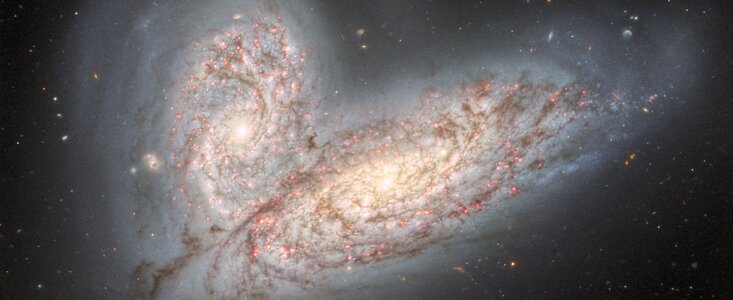

Gemini North catches a beautiful pax-de-deux
9 August 2022
Using the Gemini North telescope in Hawai'i, astronomers have just caught a spectacular image of a cosmic event around 60 million light-years away from us in the direction of the Virgo constellation. The image is of two spiral galaxies, NGC 4568 and NGC 4567 are in the process of merging to become a single elliptical galaxy in about 500 million years, in a phenomenon called 'galactic merger' in astronomy.
At the moment, the centre of these galaxies are some 20,000 light-years away from each other. This is the distance, for example, from our Earth to the centre of our home galaxy Milky Way.
Both galaxies still keep their beautiful pinwheel shape, but that will change in the future. As NGC 4568 and NGC 4567 get closer to each other, the gravitational forces between them will cause many new stars to pop out, distorting their current shape.
In the distant future, these galaxies will swing past each other over and over, like a beautiful ballet move called pax-de-deux. In each swing, NGC 4568 and NGC 4567 will get closer and closer, drawing out long streams of gas and stars until they become a single, spherical new galaxy (maybe like their neighbour Messier 89, at the Virgo cluster).
By then, most of the gas and dust (the fuel that creates stars) will have been used up or blown away.
This beautiful dance is a preview of what will happen when our Milky Way collides with our closest neighbour, the Andromeda galaxy, about 5 billion years in the future.
Image: This image from the Gemini North telescope in Hawai‘i reveals a pair of interacting spiral galaxies — NGC 4568 (bottom) and NGC 4567 (top) — as they begin to clash and merge. Credits: International Gemini Observatory/NOIRLab/NSF/AURA. Image processing: T.A. Rector (University of Alaska Anchorage/NSF's NOIRLab), J. Miller (Gemini Observatory/NSF's NOIRLab), M. Zamani (NSF’s NOIRLab) & D. de Martin (NSF’s NOIRLab)
Cool Fact
Messier 89, the older galaxy astronomers are looking at when they study the merger of NGC 4568 and NGC 4567, now has very little star formation and is made of very old, low-mass stars and ancient globular clusters.
